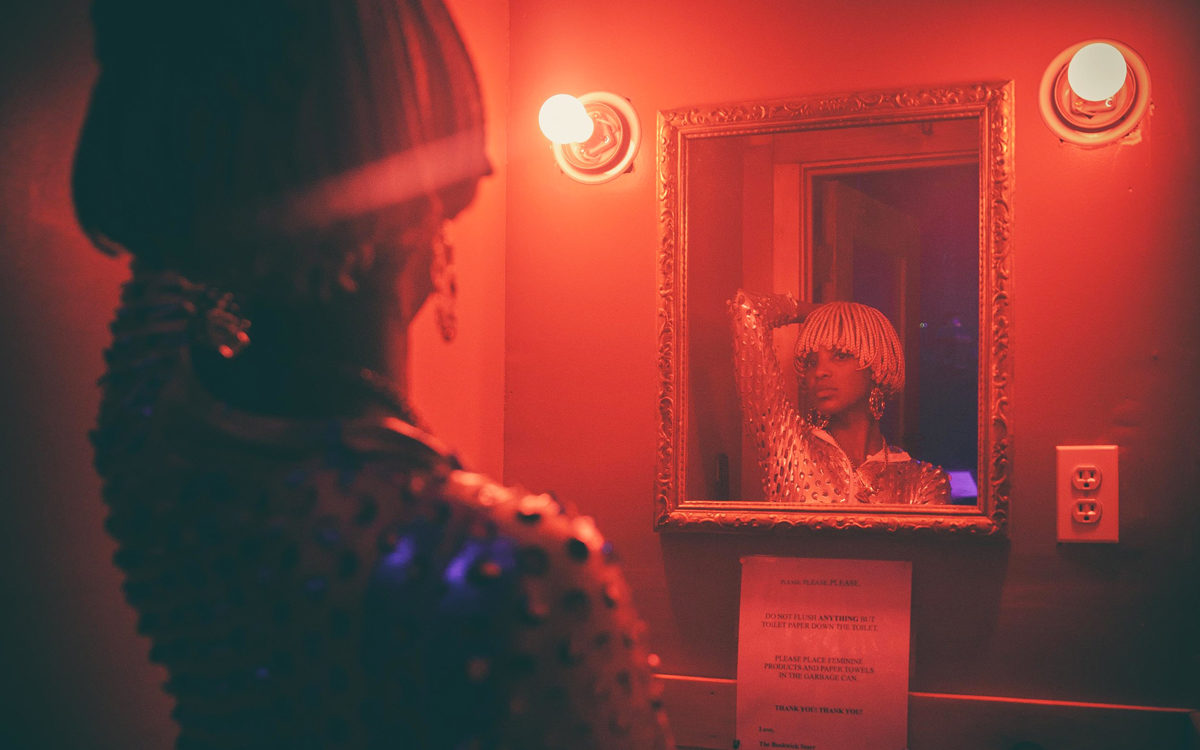Reserve your ticket to Line by Line, part of the MIT Performing series
February 15, 2019 / 8:00pm
MIT Theater Building W97, 345 Vassar Street, Cambridge, MA
Ayesha Jordan brings her mega-party persona and work-in-progress to MIT Performing
When Shasta Geaux Pop—Ayesha Jordan’s hip-pop alter-ego—performed at the Public Theater’s 2018 Under the Radar Festival, the audacious performer took over the theater lobby, where she touched down like a mothership checking in on some dizzy and worshipful Earthlings.
Glittering in a golden spiked helmet and mirrored Amazonian breastplate, Shasta proceeded to dance on the bar, march through the crowd and spin a color guard rifle over her head, as she leapt onto tables to sing Millie Jackson-style R&B and EDM-inflected pop. (She was both the party and the disco ball.) If you listened closely, Jordan’s voice was there too, performing a sex-positive, Southern-inflected, tart-tongued satire.
Jordan (and Shasta) will touch down at MIT for a week-long residency in February, along with her collaborator, the composer/artist Justin Hicks. On February 15, as part of the inaugural MIT Performing series, the duo will present a developmental stage of their new piece, Line By Line, as part of a massive expansion of Jordan’s Shasta project.
Speaking from Sydney, where she’s on tour with Geoff Sobelle’s Home, Jordan spoke about Shasta in the third person. There’s a sense that her performance-art creation is a kind of autonomous figure, that Shasta is another collaborator, responsible in her own way for content and critique.
“Shasta was born when I was living in Atlanta,” Jordan explains. “I was getting so frustrated because it was just pop stars getting all these roles in films and TV! I thought, well, maybe if I become a famous rapper, I can finally book a movie.” The character’s name derives from the retro soft drink, with the “Geaux” pronounced “Goes,” despite its Francophone spelling. In Jordan’s mind, Shasta is bright colors, the ‘80s and effervescence (she cites Pee Wee Herman as an influence); she’s also deeply rooted in the Creole South.
Jordan began writing songs for Shasta that poked fun at pop culture excesses, starting with her signature song, “Drunk and Famous.” Says Jordan, “At that time Paris Hilton and Nicole Richie were getting in trouble for DUIs, and I thought, there’s something to that! I started with the songs, then the persona came to life. Shasta was born August 17th—technically, she’s a Leo.”
That progression—which starts with being famous and works backwards—enabled Jordan to crack open certain inhibitions as performer, a process that began when she moved to New York in 2008. Jordan was always on the lookout for ways to let Shasta loose.
While her own performance style is exuberant (theater director Charlotte Brathwaite, Assistant Professor of Theater Arts at MIT, once called Jordan “radiant”) it was shy of Shasta-level outrageousness. “But once you get past the fear of what other people think, everything is possible! With Shasta, you don’t have to censor yourself.”
Shasta’s liberation has vaulted the past two years with a sloshed Mardi Gras video with Tatiana McCabe, a production at the experimental space the Bushwick Starr, a wild “guided party” on the High Line park in Chelsea and a tour that went to Amsterdam and San Diego’s WOW Festival. “She cracked through the ceiling and is trying to take over the world,” Jordan laughs.
At MIT, Jordan and Hicks will develop the blueprint for a show that will premiere in 2020 at the New York cultural space, The Shed. “MIT has all of these brilliant minds, so we’ll see how we can get the students to help us with aspects like live-video, light, and sound,” says Jordan, adding that the scaleup from lobbies and black boxes to the massive Shed will require another level of crowd control, since Shasta really likes to interact with her fans.
She also knows how to open up an audience. The mega-partier once got people to partner up with strangers to, well, kegel together. “Shasta’s whole song “Kegel to the Beat,” is strangers just…squeezing and releasing,” Jordan laughs. At MIT, she’ll experiment in how to create that type of intimate inter-audience connection without, necessarily, a sphincter-control element.
Jordan looks forward to digging deep into Shasta’s background. “I want the show at the Shed to hit a bit harder,” she says, acknowledging that her work is turning more explicitly political. The title Line by Line evokes many things: a step-by-step approach, ancestral lines, and the New Orleans tradition of second line parades. “What if Shasta went home to Louisiana? It’s such a rich, rich culture and such a dark history too.”
In many ways, Jordan brings the most porous of all the works to the 2018-2019 MIT Performing series, the piece that will be most influenced by the students who witness it. “Shasta is a pop star making fun of herself—both part of this world and talking about it,” Jordan says. “She makes it safer for the audience to look at themselves.”
While the audience holds up a mirror, Shasta will also be looking at you. So conduct yourselves accordingly, everybody: get up on that bar and dance.



